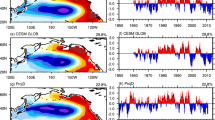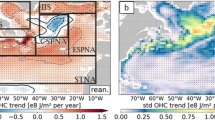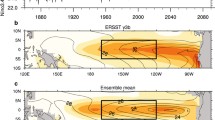Abstract
Decadal variability in the ocean is an important indicator of climate system shifts and has considerable influences on marine ecosystems. We investigate the responses of decadal variability over the global ocean regions using nine CMIP6 models (BCC-CSM2-MR, CESM2-WACCM, CMCC-ESM2, EC-Earth3-Veg-LR, FGOAL-f3-L, INM-CM5-0, MIROC6, MPI-ESM1-2-LR, and NorESM2-MM). Our results show that climate models can capture the Pacific Decadal Oscillation, Tropical Pacific Decadal Variability, South Pacific Decadal Oscillation, and Atlantic Multidecadal Variability under present-day conditions. The ocean decadal variabilities are becoming weaker and their periods are decreasing, especially under the strong global warming scenario. However, there is a discrepancy between the Tropical Pacific Decadal Variability and the other three modes of climate variability. This might be caused by the nearly unchanged atmospheric forcing in the equatorial region, which is decreasing in the higher latitude regions.
Similar content being viewed by others
Avoid common mistakes on your manuscript.
1 Introduction
In recent years, ocean decadal variability has attracted ever-increasing attention for its importance in modulating global warming (England et al. 2014; Bordbar et al. 2017). In its sixth assessment report (AR6), the Intergovernmental Panel on Climate Change (IPCC) clearly affirmed the significant contribution of human activity to the warming of the atmosphere, oceans, and land by increasing carbon dioxide (CO2) emissions since the Industrial Revolution (Li 2022; Thapliyal et al. 2023). However, the increase in global mean surface temperature (GMST) is not linear but instead has two alternating phases, which include accelerated warming and a global warming hiatus (IPCC, 2013). GMST increased rapidly during 1920–1945 and 1977–2000 but stalled during 1946–1976 and 2001–2013 (England et al. 2014, 2015; Bordbar et al. 2019). The common view is that greenhouse gases and anthropogenic aerosols dominate long-term warming trends, while natural internal variability determines the climate system phase shift (Farneti 2017). By conducting the pacemaker experiments, it was suggested that the global warming hiatus may be caused by the negative phase of the Pacific Decadal Oscillation (PDO) and Atlantic Multidecadal Variability (AMV) (Kosaka and ** rate (Wu and Liu 2020). This result is established in the mid-high latitudes, and the tropical atmosphere forcing seems to change little under global warming (Fig. S15e–h). The shortened period is caused by the acceleration of ocean Rossby waves (Fang et al. 2014) which is also different in the equatorial regions.
Overall, under global warming, the shortening and weakening of the decadal variabilities are both robust across the global regions in CMIP6 models. And the shortening of periods is also established in the CESM large ensemble with longer data length (180 years) (Fig. S16). However, the TPDV has a weaker response which might be related to the tropical atmospheric forcing. And the pattern of the decadal variabilities will not change in the future, which suggests the dynamical process may not change under global warming. However, the expression outside the chosen regions of each decadal variability is weakened in the future scenarios (Figs. S1–4), which could be related to the change of teleconnection between different regions or the industrial aerosols or greenhouse gases forcing signal in decadal variabilities indices (Baek et al. 2022). In this study, we provide an overview of the responses of global ocean decadal variability in the future. Further studies are needed to verify these results by using longer data and understanding the mechanism in different regions.
Data availability
The ERSST dataset is downloaded from https://www.ncei.noaa.gov/products/extended-reconstructed-sst. The CMIP6 dataset is downloaded from https://esgf-node.llnl.gov/search/cmip6/. The datasets generated during and/or analyzed during the current study are available from the corresponding author on reasonable request.
References
Alexander M (2010) Extratropical air–sea interaction, sea surface temperature variability, and the Pacific decadal oscillation. Clim Dyn 123:148
Baek SH, Kushnir Y, Ting M, Smerdon JE, Lora JM (2022) Regional signatures of forced north atlantic sst variability: a limited role for aerosols and greenhouse gases. Geophys Res Lett 49(8):e2022GL097794
Bordbar MH, Martin T, Latif M, Park W (2017) Role of internal variability in recent decadal to multidecadal tropical Pacific climate changes. Geophys Res Lett 44:4246–4255
Bordbar MH, England MH, Sen Gupta A, Santoso A, Taschetto AS, Martin T, Park W, Latif M (2019) Uncertainty in near-term global surface warming linked to tropical Pacific climate variability. Nat Commun 10:1990
Cheng J, Liu Z, Zhang S, Liu W, Dong L, Liu P, Li H (2016) Reduced interdecadal variability of Atlantic meridional overturning circulation under global warming. Proc Natl Acad Sci 113(12):3175–3178
Chu P-S, Clark JD (1999) Decadal variations of tropical cyclone activity over the central North Pacific. Bull Am Meteor Soc 80(9):1875–1882
Clement A, Bellomo K, Murphy LN, Cane MA, Mauritsen T, Rädel G, Stevens B (2015) The Atlantic multidecadal oscillation without a role for ocean circulation. Science 350(6258):320–324
Deser C, Blackmon ML (1993) Surface climate variations over the North Atlantic Ocean during winter: 1900–1989. J Clim 6(9):1743–1753
Deser C, Alexander MA, **e S-P, Phillips AS (2010) Sea surface temperature variability: patterns and mechanisms. Annu Rev Mar Sci 2(1):115–143
Deser C, Guo R, Lehner F (2017) The relative contributions of tropical Pacific sea surface temperatures and atmospheric internal variability to the recent global warming hiatus. Geophys Res Lett 44(15):7945–7954
Di Lorenzo E, Mantua N (2016) Multi-year persistence of the 2014/15 North Pacific marine heatwave. Nat Clim Chang 6(11):1042–1047
Di Lorenzo E, Schneider N, Cobb KM, Franks P, Chhak K, Miller AJ, McWilliams JC, Bograd SJ, Arango H, Curchitser E (2008) North Pacific gyre oscillation links ocean climate and ecosystem change. Geophys Res Lett 35:L08607
Di Lorenzo E, Xu T, Zhao Y, Newman M, Capotondi A, Stevenson S, Amaya D, Anderson B, Ding R, Furtado J (2023) Modes and mechanisms of Pacific decadal-scale variability. Ann Rev Mar Sci 15:249–275
Ding H, Greatbatch RJ, Latif M, Park W, Gerdes R (2013) Hindcast of the 1976/77 and 1998/99 climate shifts in the Pacific. J Clim 26(19):7650–7661
Ding H, Newman M, Alexander MA, Wittenberg AT (2019) Diagnosing secular variations in retrospective ENSO seasonal forecast skill using CMIP5 model-analogs. Geophys Res Lett 46(3):1721–1730
Enfield DB, Mestas-Nuñez AM, Trimble PJ (2001) The Atlantic multidecadal oscillation and its relation to rainfall and river flows in the continental US. Geophys Res Lett 28(10):2077–2080
England MH, McGregor S, Spence P, Meehl GA, Timmermann A, Cai W, Gupta AS, McPhaden MJ, Purich A, Santoso A (2014) Recent intensification of wind-driven circulation in the Pacific and the ongoing warming hiatus. Nat Clim Chang 4(3):222–227
England MH, Kajtar JB, Maher N (2015) Robust warming projections despite the recent hiatus. Nat Clim Chang 5:394–396
Fang C, Wu L, Zhang X (2014) The impact of global warming on the Pacific decadal oscillation and the possible mechanism. Adv Atmos Sci 31(1):118–130
Farneti R (2017) Modelling interdecadal climate variability and the role of the ocean. Wiley Interdisc Rev 8(1):e441
Flandrin P, Rilling G, Goncalves P (2004) Empirical mode decomposition as a filter bank. IEEE Sign Process Lett 11(2):112–114
Hare SR, Mantua NJ, Francis RC (1999) Inverse production regimes: Alaska and west coast Pacific salmon. Fisheries 24(1):6–14
Hawkins E, Sutton R (2009) The potential to narrow uncertainty in regional climate predictions. Bull Am Meteor Soc 90(8):1095–1108
Holbrook NJ, Scannell HA, Sen Gupta A, Benthuysen JA, Feng M, Oliver EC, Alexander LV, Burrows MT, Donat MG, Hobday AJ (2019) A global assessment of marine heatwaves and their drivers. Nat Commun 10(1):1–13
Hsu HH, Chen YL (2011) Decadal to bi‐decadal rainfall variation in the western Pacific: a footprint of South Pacific decadal variability? Geophys Res Lett 38:L03703
Huang B, Banzon VF, Freeman E, Lawrimore J, Liu W, Peterson TC, Smith TM, Thorne PW, Woodruff SD, Zhang H-M (2015) Extended reconstructed sea surface temperature version 4 (ERSST. v4). Part I: upgrades and intercomparisons. J Clim 28(3):911–930
Huang J, **e Y, Guan X, Li D, Ji F (2017) The dynamics of the warming hiatus over the Northern Hemisphere. Clim Dyn 48(1):429–446
IPCC (2013) Climate Change 2013: the Physical Science Basis. Working Group I Contribution to the Fifth Assessment of the Intergovernmental Panel on Climate Change. Cambridge University Press, Cambridge and New York
Joyce TM, Zhang R (2010) On the path of the Gulf Stream and the Atlantic meridional overturning circulation. J Clim 23(11):3146–3154
Kosaka Y, **e S-P (2013) Recent global-warming hiatus tied to equatorial Pacific surface cooling. Nature 501(7467):403–407
Kushnir Y (1994) Interdecadal variations in North Atlantic sea surface temperature and associated atmospheric conditions. J Clim 7(1):141–157
Li D (2022) Physical processes and feedbacks obscuring the future of the Antarctic Ice Sheet. Geosystems and Geoenvironment 1(4):100084
Li W, Li L, Deng Y (2015) Impact of the interdecadal Pacific oscillation on tropical cyclone activity in the North Atlantic and eastern North Pacific. Sci Rep 5(1):1–8
Li S, Wu L, Yang Y, Geng T, Cai W, Gan B, Chen Z, **g Z, Wang G, Ma X (2020) The Pacific decadal oscillation less predictable under greenhouse warming. Nat Clim Chang 10(1):30–34
Liu Z (2012) Dynamics of interdecadal climate variability: a historical perspective. J Clim 25(6):1963–1995
Liu Z, Di Lorenzo E (2018) Mechanisms and predictability of Pacific decadal variability. Curr Clim Chang Rep 4(2):128–144
Liu W, Huang B, Thorne PW, Banzon VF, Zhang H-M, Freeman E, Lawrimore J, Peterson TC, Smith TM, Woodruff SD (2015) Extended reconstructed sea surface temperature version 4 (ERSST. v4): Part II. Parametric and structural uncertainty estimations. J Clim 28(3):931–951
Mantua NJ, Hare SR, Zhang Y, Wallace JM, Francis RC (1997) A Pacific interdecadal climate oscillation with impacts on salmon production. Bull Am Meteor Soc 78(6):1069–1080
McGregor S, Timmermann A, Stuecker MF, England MH, Merrifield M, ** F-F, Chikamoto Y (2014) Recent walker circulation strengthening and Pacific cooling amplified by Atlantic warming. Nat Clim Chang 4(10):888–892
Newman M, Alexander MA, Ault TR, Cobb KM, Deser C, Di Lorenzo E, Mantua NJ, Miller AJ, Minobe S, Nakamura H (2016) The Pacific decadal oscillation, revisited. J Clim 29(12):4399–4427
O’Neill BC, Tebaldi C, Van Vuuren DP, Eyring V, Friedlingstein P, Hurtt G, Knutti R, Kriegler E, Lamarque J-F, Lowe J (2016) The scenario model intercomparison project (ScenarioMIP) for CMIP6. Geosci Model Dev 9(9):3461–3482
Power S, Casey T, Folland C, Colman A, Mehta V (1999) Inter-decadal modulation of the impact of ENSO on Australia. Clim Dyn 15(5):319–324
Roemmich D, McGowan J (1995) Climatic warming and the decline of zooplankton in the California current. Science 267(5202):1324–1326
Shakun JD, Shaman J (2009) Tropical origins of North and South Pacific decadal variability. Geophys Res Lett 36:L19711
Smith TM, Reynolds RW, Peterson TC, Lawrimore J (2008) Improvements to NOAA’s historical merged land–ocean surface temperature analysis (1880–2006). J Clim 21(10):2283–2296
Song YH, Chung E-S, Shahid S (2022) Uncertainties in evapotranspiration projections associated with estimation methods and CMIP6 GCMs for South Korea. Sci Total Environ 825:153953
Taylor KE (2001) Summarizing multiple aspects of model performance in a single diagram. J Geophys Res 106(D7):7183–7192
Thapliyal A, Kimothi S, Taloor AK, Bisht MP, Mehta P, Kothyari GC (2023) Glacier retreat analysis in the context of climate change impact over the Satopanth (SPG) and Bhagirathi-Kharak (BKG) glaciers in the Mana basin of the Central Himalaya, India: A geospatial approach. Geosystems and Geoenvironment 2(1):100128
Wang J, Li C (2017) Low-frequency variability and possible changes in the North Pacific simulated by CMIP5 models. J Meteorol Soc Japan Ser II 95:199
Wu S, Liu Z-Y (2020) Decadal variability in the North Pacific and North Atlantic under global warming: the weakening response and its mechanism. J Clim 33(21):9181–9193
Wu S, Liu Z-Y, Cheng J, Li C (2018) Response of North Pacific and North Atlantic decadal variability to weak global warming. Adv Clim Chang Res 9(2):95–101
Wu S, Liu Z, Du J, Liu Y (2022) Change of global ocean temperature and decadal variability under 1.5° C warming in FOAM. J Mar Sci Eng 10(9):1231
Zhang Y, Wallace JM, Battisti DS (1997) ENSO-like interdecadal variability: 1900–93. J Clim 10(5):1004–1020
Zhang R, Sutton R, Danabasoglu G, Delworth TL, Kim WM, Robson J, Yeager SG (2016) Comment on “The Atlantic multidecadal oscillation without a role for ocean circulation.” Science 352(6293):1527–1527
Zhang R, Sutton R, Danabasoglu G, Kwon YO, Marsh R, Yeager SG, Amrhein DE, Little CM (2019) A review of the role of the Atlantic meridional overturning circulation in Atlantic multidecadal variability and associated climate impacts. Rev Geophys 57(2):316–375
Funding
This work is supported by the National Natural Science Foundation of China under Grant 42105043, and Chinese MOST (2017YFA0603801). The analyses are performed on the Marine Big Data Center of Institute for Advanced Ocean Study of Ocean University of China and High-performance Computing Platform of Peking University. This work is also supported by Postdoctoral Innovation Project of Shandong Province.
Author information
Authors and Affiliations
Corresponding author
Ethics declarations
Competing interests
The authors declare no competing interests.
Additional information
Responsible Editor: Richard John Greatbatch
Supplementary Information
Below is the link to the electronic supplementary material.
Rights and permissions
Open Access This article is licensed under a Creative Commons Attribution 4.0 International License, which permits use, sharing, adaptation, distribution and reproduction in any medium or format, as long as you give appropriate credit to the original author(s) and the source, provide a link to the Creative Commons licence, and indicate if changes were made. The images or other third party material in this article are included in the article's Creative Commons licence, unless indicated otherwise in a credit line to the material. If material is not included in the article's Creative Commons licence and your intended use is not permitted by statutory regulation or exceeds the permitted use, you will need to obtain permission directly from the copyright holder. To view a copy of this licence, visit http://creativecommons.org/licenses/by/4.0/.
About this article
Cite this article
Shang, Y., Liu, P. & Wu, S. Responses of the Pacific and Atlantic decadal variabilities under global warming by using CMIP6 models. Ocean Dynamics 74, 67–75 (2024). https://doi.org/10.1007/s10236-023-01590-8
Received:
Accepted:
Published:
Issue Date:
DOI: https://doi.org/10.1007/s10236-023-01590-8




